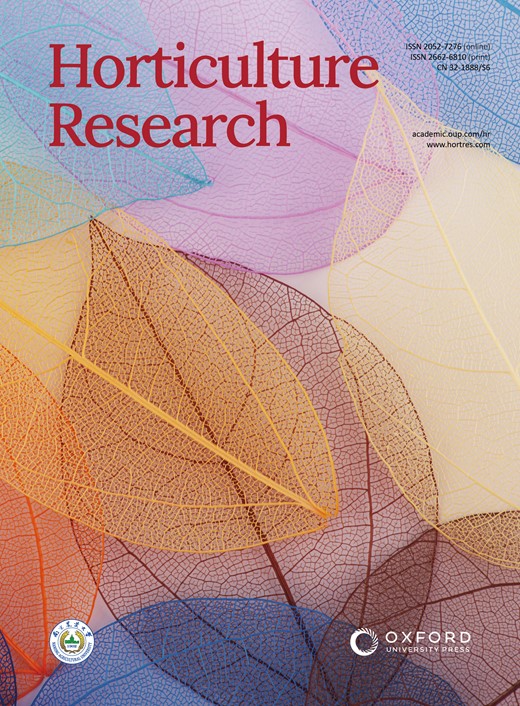TOR 通过协调番茄的氨基酸代谢平衡植物生长和耐寒性
IF 8.7
1区 农林科学
Q1 Agricultural and Biological Sciences
引用次数: 0
摘要
雷帕霉素靶蛋白激酶(TOR)是一个中心信号枢纽,在精确协调植物生长、发育和胁迫响应方面发挥着至关重要的作用。这表明 TOR 密切参与了维持植物生长和胁迫反应之间的平衡。然而,尽管观察到了这些影响,但 TOR 在这些过程中的具体作用机制仍然模糊不清。在本研究中,我们研究了番茄(Solanum lycopersicum)TOR(SlTOR)如何影响植物生长和冷反应。我们证明,抑制 SlTOR 可使冷胁迫反应转录激活,从而增强番茄的耐寒性。一项广泛的靶向代谢组学分析表明,在抑制 SlTOR 后,冷胁迫下的氨基酸代谢平衡被破坏,导致两种重要的低温保护性代谢产物:水杨酸(SA)和腐胺(Put)的积累。接着,我们发现 SlPGH1(2-PHOSPHO-D-GLYCERATE HYDRO-LYASE)是 SlTOR 的直接底物。抑制 SlTOR 会导致 SlCBF1(C-REPEAT-BINDING FACTOR 1)通过 SlPGH1 表达增加,从而可能引发冷反应基因的激活和随后的代谢改变。我们的研究提供了一个机理框架,阐明了 SlTOR 如何调节氨基酸相关代谢以提高番茄的耐寒性,从而揭示了 TOR 协调的生长和胁迫响应之间复杂的相互作用。本文章由计算机程序翻译,如有差异,请以英文原文为准。
TOR balances plant growth and cold tolerance by orchestrating amino acid-derived metabolism in tomato
The target of rapamycin (TOR) kinase is a central signaling hub that plays a crucial role in precisely orchestrating plant growth, development, and stress responses. This suggests that TOR is intricately involved in maintaining the balance between plant growth and stress responses. Nevertheless, despite the observed effects, the specific mechanisms through which TOR operates in these processes remain obscure. In this study, we investigated how the tomato (Solanum lycopersicum) TOR (SlTOR) affects plant growth and cold responses. We demonstrated that SlTOR inhibition transcriptionally primes cold stress responses, consequently enhancing tomato cold tolerance. A widely targeted metabolomics analysis revealed the disruption of amino acid metabolism homeostasis under cold stress upon SlTOR inhibition, which led to the accumulation of two important cryoprotective metabolites: salicylic acid (SA) and putrescine (Put). Next, we discovered SlPGH1 (2-PHOSPHO-D-GLYCERATE HYDRO-LYASE) as a direct substrate of SlTOR. Inhibiting SlTOR led to increased SlCBF1 (C-REPEAT-BINDING FACTOR 1) expression via SlPGH1, potentially triggering the activation of cold-responsive genes and subsequent metabolic alterations. Our study provides a mechanistic framework that elucidates how SlTOR modulates amino acid-related metabolism to enhance tomato cold tolerance, which sheds light on the complex interplay between growth and stress responses orchestrated by TOR.
求助全文
通过发布文献求助,成功后即可免费获取论文全文。
去求助
来源期刊

Horticulture Research
Biochemistry, Genetics and Molecular Biology-Biochemistry
CiteScore
11.20
自引率
6.90%
发文量
367
审稿时长
20 weeks
期刊介绍:
Horticulture Research, an open access journal affiliated with Nanjing Agricultural University, has achieved the prestigious ranking of number one in the Horticulture category of the Journal Citation Reports ™ from Clarivate, 2022. As a leading publication in the field, the journal is dedicated to disseminating original research articles, comprehensive reviews, insightful perspectives, thought-provoking comments, and valuable correspondence articles and letters to the editor. Its scope encompasses all vital aspects of horticultural plants and disciplines, such as biotechnology, breeding, cellular and molecular biology, evolution, genetics, inter-species interactions, physiology, and the origination and domestication of crops.
 求助内容:
求助内容: 应助结果提醒方式:
应助结果提醒方式:


